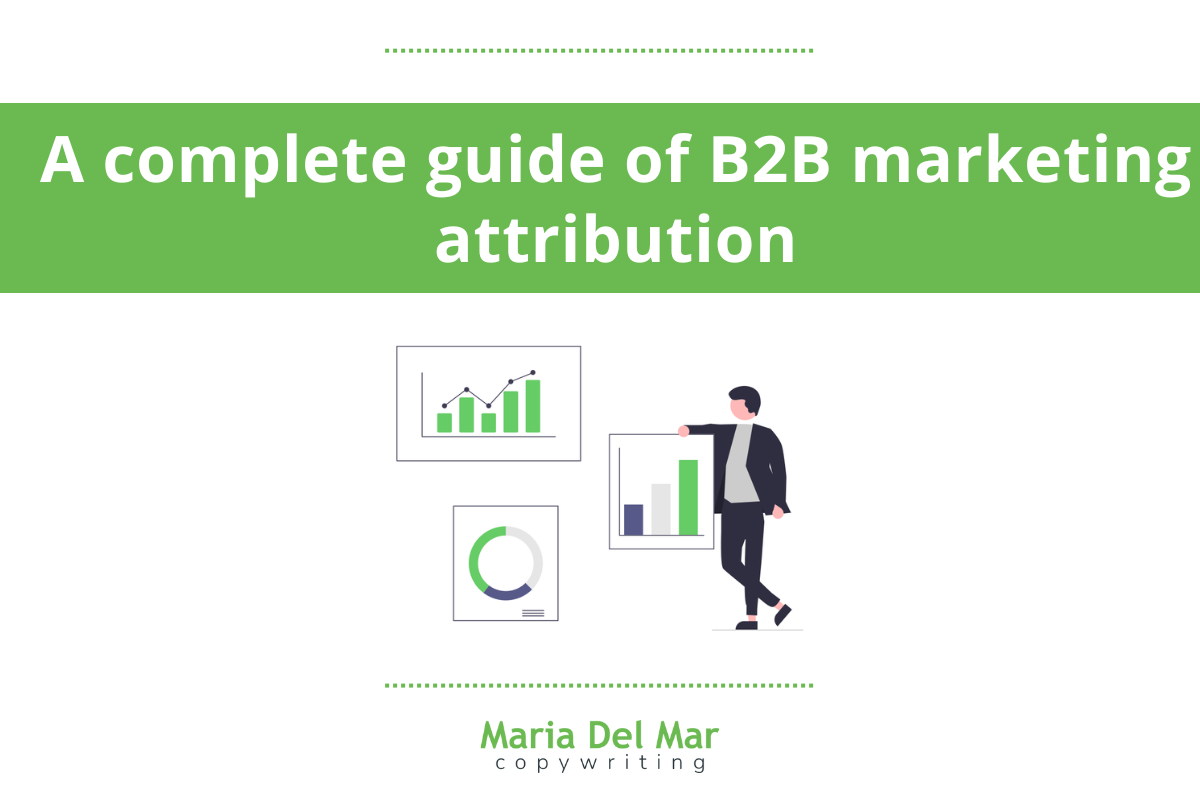In today’s fast-paced digital world, companies decide to increase their investment in various marketing channels, ranging from SEO and email marketing to social media and content marketing.
Having made this investment, companies want to understand and optimise their marketing efforts.
For B2B companies, this is a complex task because the customer journey is so long and can involve multiple touch points across multiple channels, by multiple stakeholders, over multiple months or even years.
Then, a question arises.
How can B2B businesses accurately measure the impact of their marketing touchpoints and attribute success to the right channels?
That’s where B2B marketing attribution steps in.
In this article, we’ll dive into what marketing attribution modelling is, its importance for B2B businesses, different types of attribution models, some practices to keep in mind, and powerful tools to start measuring your marketing efforts accurately.
Let’s get started.
What is B2B marketing attribution?
As the name suggests, B2B marketing attribution refers to the process of identifying and assigning credit to various marketing channels or touchpoints that contribute to a desired outcome or conversion within a B2B context.
Essentially, it’s about understanding which marketing efforts are driving results, such as leads, sales, or conversions, and determining the relative impact of each channel or tactic in the customer’s journey.
Why is it important?
The B2B customer journey is considerably more complex than the B2C journey. To make a purchase decision in B2B, numerous people from various departments are frequently consulted.
Also, another essential factor to consider in B2B buying decisions is the fragmentation of the internet ecosystem. Multiple sales funnel touchpoints across several channels are frequently necessary to reach and engage target consumers.
So, here’s where B2B marketing attribution can help:
- Improving the alignment of sales
- Allocating the budget more effectively
- Understanding complex customer journeys
- Making more effective data-driven decisions
- Building long-term relationships
- Determining ROI on marketing campaigns
In a nutshell, without B2B attribution modelling, companies are essentially operating in the dark, with no visibility into the effectiveness of their marketing efforts. It’s like throwing resources into a bottomless pit and hoping for the best outcome.
However, with B2B attribution modelling in place, businesses can have confidence in leveraging data-driven insights to steer towards success.
What are the different marketing attribution models?
As a B2B marketer, running complex campaigns designed to reach customers across multiple touchpoints has allowed me to observe that my customers are taking different paths to conversions.
That brings us to the attribution models, also known as revenue attribution models.
There are several that can offer a more sophisticated overview of your customer journey. The most common attribution models for marketing are:
First-touch attribution
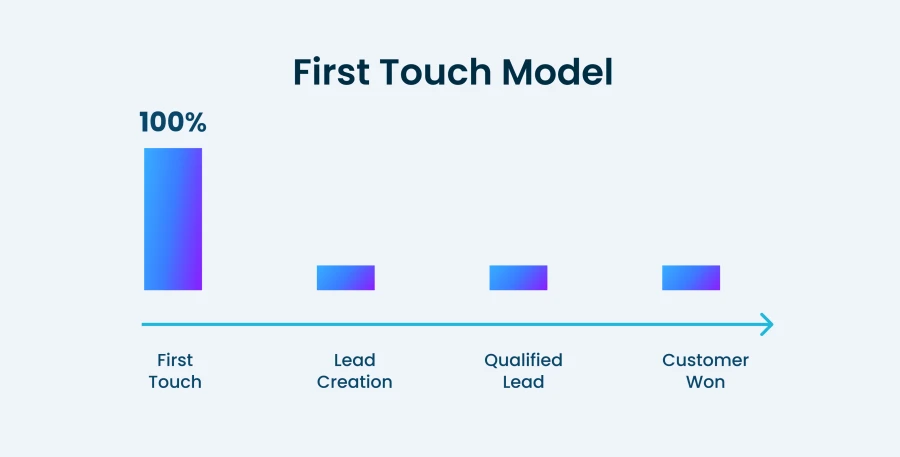
First Touch Attribution (FTA) attributes the entire conversion value to the first touchpoint a customer interacted with.
It’s a single-touch attribution model that attributes all credit to the first touchpoint.
- Advantages: Highlights the initial engagement that brought a customer into the sales funnel, useful for understanding top-of-funnel effectiveness.
- Disadvantages: Neglects the impact of subsequent touchpoints and channels that may have influenced the customer’s decision. In a nutshell, oversimplifies the customer journey.
Last-touch attribution
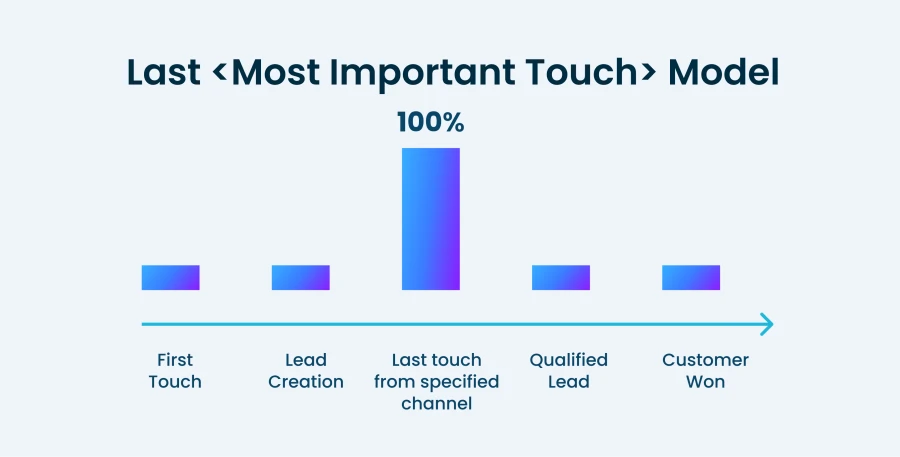
Last touch attribution (LTA) gives credit for a conversion to the last touchpoint a customer interacted with before making a purchase or completing a desired action.
It’s a single-touch attribution model that attributes all credit to the last touchpoint.
- Advantages: Simple to implement and understand, provides clear insight into the final step of the customer journey.
- Disadvantages: Ignores the influence of previous touchpoints in the customer journey, may undervalue the contribution of earlier marketing efforts.
Linear attribution
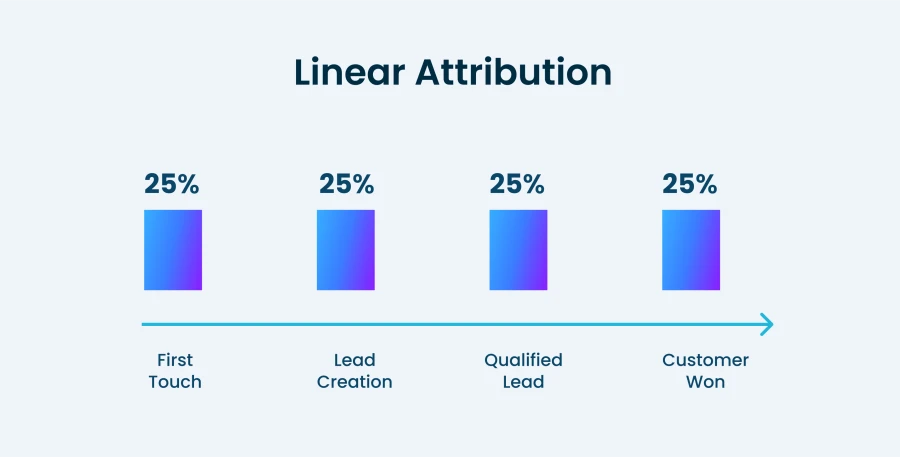
Linear attribution distributes equal credit to each touchpoint along the customer journey, regardless of when it occurred.
It’s a multi-touch attribution model that attributes credit to all touchpoints equally.
- Advantages: Provides a more balanced view of the customer journey by acknowledging the contribution of all touchpoints.
- Disadvantages: May not accurately reflect the varying impact of different touchpoints and can be overly simplistic in complex customer journeys.
Time-decay attribution
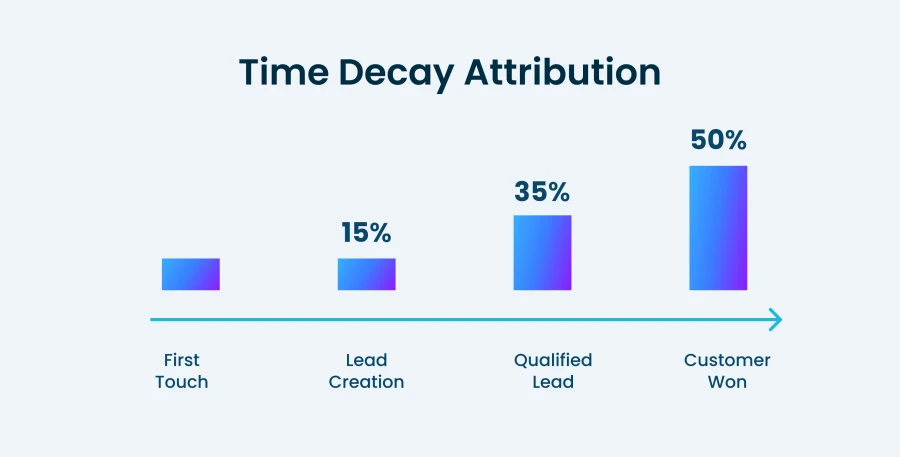
Time-decay attribution gives more credit to touchpoints that occur closer to the conversion event, assuming that these interactions have a greater influence.
It’s a multi-touch attribution model that attributes more credit to recent touchpoints.
- Advantages: Reflects the idea that recent interactions are often more influential in driving conversions, making them suitable for industries with short sales cycles.
- Disadvantages: May undervalue the importance of early touchpoints in longer customer journeys, and ignore the potential lasting impact of initial engagements.
Position-based attribution (W-Shaped)
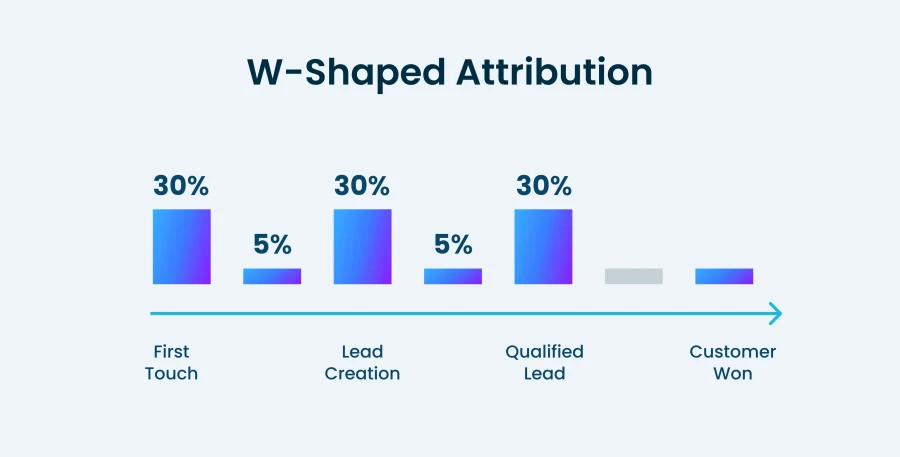
Position-based attribution assigns significant credit to both the first and last touchpoints, with the remaining credit distributed among intermediary touchpoints.
It’s a multi-touch attribution model that attributes credit to multiple touchpoints based on their position in the customer journey.
- Advantages: Recognizes the importance of both initial and final interactions in the customer journey, provides insights into the entire funnel.
- Disadvantages: Requires clear delineation of what constitutes a significant touchpoint, can be complex to implement and interpret.
Data-driven attribution
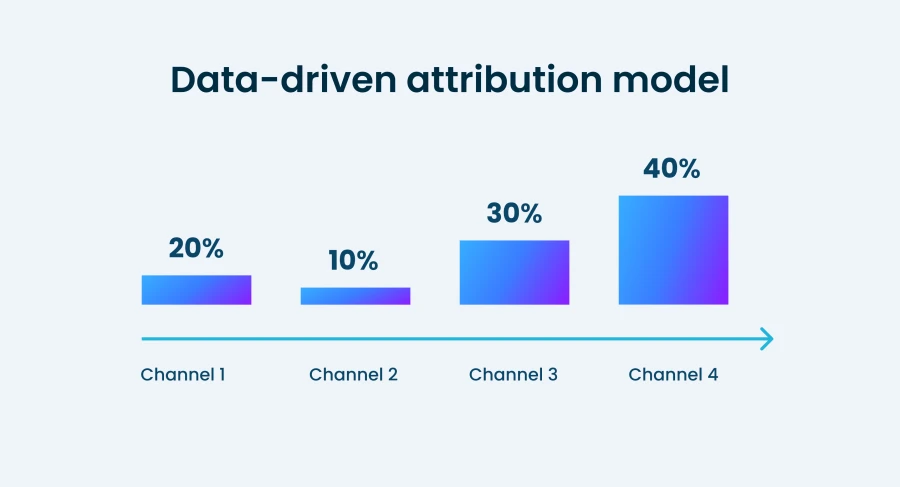
Data-driven attribution uses advanced algorithms and machine learning techniques to analyze multiple touchpoints in the customer journey and assign credit based on their actual impact on conversions.
It’s a multi-touch attribution model that analyzes and attributes credit to multiple touchpoints based on data analysis.
- Advantages: Utilizes data analysis to objectively assign credit to each touchpoint, accounts for the complexity and uniqueness of individual customer journeys.
- Disadvantages: Requires a large volume of high-quality data to train accurate attribution models, can be resource-intensive and complex to implement for organizations with limited data capabilities.
Custom attribution model
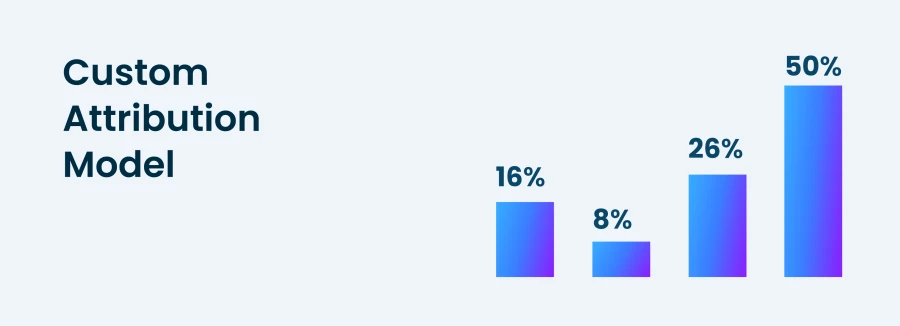
Custom attribution models are tailored to specific business needs and objectives, allowing organizations to define their own rules for assigning credit to touchpoints.
Can be either multi-touch or single-touch, depending on how the custom model is designed and implemented. It offers flexibility to accommodate both approaches based on business requirements.
- Advantages: Provides flexibility to adapt the attribution model to match unique business requirements and customer journey characteristics.
- Disadvantages: Requires in-depth understanding of the customer journey and marketing objectives to design an effective custom model, may lack standardization and comparability with off-the-shelf attribution models.
With so many options, you might be wondering how do I choose the right B2B attribution model for my business?
Each attribution model has its strengths and weaknesses, and the choice of model depends on factors such as the complexity of your customer journey, your type of industry, and the specific goals of your marketing strategy.
6 Best Practices for B2B Marketing Attribution
Incorporating marketing attribution into your company’s strategy can feel like stepping into unfamiliar terrain.
It’s not just about introducing a new concept but fundamentally reshaping how your team approaches measuring marketing effectiveness.
To help you with this task, let’s dive into six key practices to ensure the effectiveness of your B2B marketing attribution strategy:
1. Define clear objectives and KPIs
Before starting any attribution strategy, it’s essential to establish clear objectives and key performance indicators (KPIs).
These should align closely with your business goals, whether it’s increasing lead generation, improving conversion rates, or enhancing your customer retention.
By defining measurable outcomes upfront, you create a roadmap for assessing the success of your attribution efforts and guiding future strategies.
2. Begin with a small-scale approach and expand gradually
Just as Rome wasn’t built in a day, effective marketing attribution campaigns require a phased approach.
For that reason, you can start by piloting your program with a single campaign, whether it’s tied to a specific brand, channel, or asset.
This allows your team to grasp the fundamentals of marketing attribution, conduct thorough testing, and establish benchmarks for future decision-making.
3. Educate your key stakeholders about the value of marketing attribution
When educating key stakeholders about your marketing attribution strategy, focus less on the technical definition and more on the benefits it brings.
You can help them understand how marketing attribution aligns with the broader company strategy, what insights they can anticipate from these initiatives, and how it contributes to overall business advancement.
4. Use Marketing automation and CRM integration
Integrating marketing automation platforms and customer relationship management (CRM) marketers can track and attribute revenue back to specific marketing campaigns.
Also, providing invaluable insights for optimizing future efforts and nurturing leads through the sales funnel.
5. Implement data-driven decision making
Central to successful attribution is a commitment to data-driven decision making. Collecting, analyzing, and interpreting data from various sources—including website analytics, ad platforms, and CRM systems—empowers marketers to identify trends, patterns, and correlations in customer behavior.
By leveraging data insights, marketers can allocate resources more effectively, optimize campaign performance in real-time, and refine targeting strategies to resonate with their target audience.
6. Continuously revise and refine attribution models
B2B marketing attribution is not a one-time endeavour but an ongoing process that requires continual refinement and optimization.
As market dynamics evolve and consumer behaviors shift, it’s essential to adapt attribution models accordingly.
Regularly review and reassess your attribution approach, experimenting with different models, variables, and attribution methodologies to ensure alignment with business objectives and evolving market trends.
Marketing attribution tools might help you get started
When it comes to B2B marketing attribution, it’s important to have the right tools at your disposal to accurately measure and analyze your efforts.
While Google Analytics is a popular starting point for many marketers, its general focus might not provide the level of precision needed for B2B attribution.
That is precisely why the following 3 alternatives, which I explained in an extended way in a previous blog post on my LinkedIn, offer specialized features and in-depth analytics that can provide valuable insights and drive success.
1. Dreamdata
Dreamdata holds a special place in my toolkit, as I had the pleasure of working with this outstanding platform throughout my time there.
It’s not just another analytics tool; it’s my favourite one for B2B marketing attribution.
Dreamdata stands out with its laser-focused approach to B2B marketing, offering advanced features that go beyond the capabilities of generic analytics tools like Google Analytics.
Its precise attribution model is a game-changer, enabling marketers to pinpoint the most effective channels and campaigns with unmatched accuracy.
What truly sets Dreamdata apart is its ability to track revenue and ROI, allowing marketers to gauge the success of each campaign and make informed decisions to maximize revenue generation.
The funnel analysis feature provides invaluable insights into the sales funnel, empowering marketers to identify bottlenecks and optimize conversion rates.
2. Mixpanel
Mixpanel is an analytic and user behavior platform. It focuses on the user’s actions on the site, site such as signing up for a service, watching a product demo, coming back to the service after a long time and interacting with features of a product or service.
One of Mixpanel’s key strengths lies in its user-friendly interface. It provides a straightforward way for you to discover how people engage with your app or website. This insight into user behavior is invaluable for understanding how users interact with your product and identifying areas for improvement.
3. Leadfeeder
Leadfeeder is a B2B visitor identification software. It focuses on identifying the companies that visit your website -even if they don’t leave the contact information. By using this visitor identification software, you can uncover the names of the companies visiting your website and transform anonymous traffic into identifiable leads.
One of the key features of Leadfeeder is its ability to reveal the precise behavior of the companies visiting your website. This includes the specific pages they view and the actions they take. By gaining insights into their behavior, you can better understand your site visitors and make informed decisions to improve your marketing and sales strategies.
Before choosing the right B2B marketing attribution tool
Choosing the right B2B marketing attribution tool is really important, and it ultimately depends on your specific needs and objectives.
That’s why you should consider factors such as the complexity of your marketing strategy and your integration capabilities with your existing tech stack.
Additionally, evaluate the scalability and pricing structure of each tool to ensure it fits within your budget and can accommodate future growth.
I highly recommend conducting an exhaustive study to assess the strengths and weaknesses of each B2B marketing attribution tool mentioned in this article, as well as any others you may come across.
Ready to get started with marketing attribution?
As a B2B content marketer, I know that marketing attribution is important for optimizing efforts in our complex B2B landscape. From understanding attribution models to using specialized tools like Dreamdata and Mixpanel, the journey is both challenging and rewarding.
But where to start?
You can begin by defining clear objectives and piloting small-scale initiatives. Also, start educating your stakeholders and showing them the power of advanced tools to gain invaluable insights into their marketing efforts.
Remember, attribution is an ongoing journey of refinement. You have to continuously reassess your approach and adapt to evolving market dynamics to stay ahead.
If you’re ready to add marketing attribution to your company’s marketing strategy, I’m here to guide you through every step of the process.
